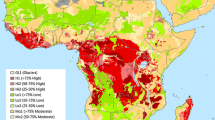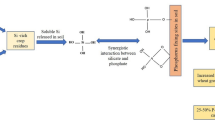Abstract
Crop production is limited by low soil fertility in sub-Saharan Africa (SSA), particularly by P deficiency due to strong fixation by Fe and Al oxyhydroxides. Organic amendments are known to increase P availability in fertilizer and in such soils by different mechanisms. This study investigated the effect of adding farmyard manure (FYM) versus mineral triple super phosphate (TSP) fertilizer on P availability in different cropping systems. Field experiments were conducted in three succeeding summer seasons to compare two different upland cropping systems: a Bambara (Vigna subterranea)–rice rotation and a rice–rice system on a highly P deficient Ferralsol. Nine treatments including sole TSP at 0, 10, 20, 30 kg P ha−1 year−1, and sole FYM at 0, 10, 20, 30 kg P ha−1 year−1 (i.e. 100% FYM substitution), and combined FYM and TSP (FYM + TSP) at 20, 30 kg P ha−1 year−1 (i.e. 50% and 67% FYM substitution, respectively) were applied. Results showed that FYM treatments increased Bambara and rice grain yields compared to TSP treatment alone particularly in year three. Phosphorus uptake efficiency was higher in FYM treatments combined or not with TSP in year three of the experiment. The notable response to FYM was associated with increased agronomic efficiency resulting from additional C originating from the FYM with a low initial soil C content, (around 2%), and the effect of liming that reduced soil P sorption thereby improving P availability from FYM. Partial (67%) substitution of TSP by FYM increased grain yields of Bambara by 1.67 Mg ha−1 and of rice by 1.01 Mg ha−1 compared to TSP alone in year three at the highest P rate (30 kg P ha−1). The effect of FYM could be linked to inputs of C and nutrients from added FYM and to the indirect effect on soil physico–chemical properties including soil pH, soil moisture, soil biological activity, low P capacity sorption. This study confirms that application of FYM can help minimize rates of TSP applied in smallholder farms in SSA.










Similar content being viewed by others
References
Andriamananjara A, Rakotoson T, Razanakoto OR et al (2018) Farmyard manure application in weathered upland soils of Madagascar sharply increase phosphate fertilizer use efficiency for upland rice. Field Crop Res 222:94–100. https://doi.org/10.1016/j.fcr.2018.03.022
Andriamananjara A, Chevallier T, Masse D et al (2019) Land management modifies the temperature sensitivity of soil organic carbon, nitrogen and phosphorus dynamics in a Ferralsol. Appl Soil Ecol 138:112–122. https://doi.org/10.1016/j.apsoil.2019.02.023
Cong PT, Merckx R (2005) Improving phosphorus availability in two upland soils of Vietnam using Tithonia diversifolia H. Plant Soil 269:11–23. https://doi.org/10.1007/s11104-004-1791-1
Core Team R (2015) R: a language and environment for statistical computing. R Foundation for Statistical Computing, Vienna
Dakora FD, Phillips DA (2002) Root exudates as mediators of mineral acquisition in low-nutrient environments. Plant Soil 245:35–47. https://doi.org/10.1023/A:1020809400075
Dijkstra F, Carrillo Y, Pendall E, Morgan J (2013) Rhizosphere priming: a nutrient perspective. Front Microbiol 4:216. https://doi.org/10.3389/fmicb.2013.00216
Dobermann A (2007) Nutrient use efficiency–measurement and management. In: Kraus A, Isherwood K, Heffer P (eds) Proceeding of international fertilizer industry association, Brussels, Belgium, pp 1–22
Drevon J-J, Abadie J, Alkama N et al (2015) Phosphorus use efficiency for N fixation in the rhizobial symbiosis with legumes. In: de Bruijn FJ (ed) Biological nitrogen fixation, 1st edn. Wiley, pp 455–464
Föhse D, Claassen N, Jungk A (1988) Phosphorus efficiency of plants. Plant Soil 110:101–109. https://doi.org/10.1007/BF02143545
George TS, Fransson A-M, Hammond JP, White PJ (2011) Phosphorus nutrition: rhizosphere processes, plant response and adaptations. In: Bünemann E, Oberson A, Frossard E (eds) Phosphorus in action: biological processes in soil phosphorus cycling. Springer, Berlin, pp 245–271
Gomiero T, Pimentel D, Paoletti MG (2011) Environmental impact of different agricultural management practices: conventional vs. organic agriculture. CRC Crit Rev Plant Sci 30:95–124. https://doi.org/10.1080/07352689.2011.554355
Guppy CN, Menzies NW, Moody PW, Blamey FPC (2005) Competitive sorption reactions between phosphorus and organic matter in soil: a review. Soil Res 43:189–202
Hao XH, Liu SL, Wu JS et al (2008) Effect of long-term application of inorganic fertilizer and organic amendments on soil organic matter and microbial biomass in three subtropical paddy soils. Nutr Cycl Agroecosyst 81:17–24. https://doi.org/10.1007/s10705-007-9145-z
Hati KM, Mandal KG, Misra AK et al (2006) Effect of inorganic fertilizer and farmyard manure on soil physical properties, root distribution, and water-use efficiency of soybean in Vertisols of central India. Bioresour Technol 97:2182–2188. https://doi.org/10.1016/j.biortech.2005.09.033
Haynes RJ (1984) Lime and phosphate in the soil–plant system. Adv Agron 37:249–315. https://doi.org/10.1016/S0065-2113(08)60456-3
Haynes RJ, Mokolobate MS (2001) Amelioration of Al toxicity and P deficiency in acid soils by additions of organic residues: a critical review of the phenomenon and the mechanisms involved. Nutr Cycl Agroecosyst 59:47–63. https://doi.org/10.1023/A:1009823600950
Haynes RJ, Naidu R (1998) Influence of lime, fertilizer and manure applications on soil organic matter content and soil physical conditions: a review. Nutr Cycl Agroecosyst 51:123–137. https://doi.org/10.1023/A:1009738307837
Hinsinger P, Betencourt E, Bernard L et al (2011) P for two, sharing a scarce resource: soil phosphorus acquisition in the rhizosphere of intercropped species. Plant Physiol 156:1078–1086. https://doi.org/10.1104/pp.111.175331
Hue NV (1991) Effects of organic acids/anions on P sorption and phytoavailability in soils with different mineralogies. Soil Sci 152:463–471
Jiang D, Hengsdijk H, Dai T-B et al (2006) Long-term effects of manure and inorganic fertilizers on yield and soil fertility for a winter wheat-maize system in Jiangsu, China 11 Project supported by the National Natural Science Foundation of China (No. 30030090) and the National High-Tech Research. Pedosphere 16:25–32. https://doi.org/10.1016/S1002-0160(06)60022-2
Khan A, Lu G, Ayaz M et al (2018) Phosphorus efficiency, soil phosphorus dynamics and critical phosphorus level under long-term fertilization for single and double cropping systems. Agric Ecosyst Environ 256:1–11. https://doi.org/10.1016/j.agee.2018.01.006
Li C, Dong Y, Li H et al (2016) Shift from complementarity to facilitation on P uptake by intercropped wheat neighboring with faba bean when available soil P is depleted. Sci Rep 6:18663. https://doi.org/10.1038/srep18663
Liang Q, Chen H, Gong Y et al (2012) Effects of 15 years of manure and inorganic fertilizers on soil organic carbon fractions in a wheat-maize system in the North China Plain. Nutr Cycl Agroecosystems 92:21–33. https://doi.org/10.1007/s10705-011-9469-6
Liu M, Hu F, Chen X et al (2009) Organic amendments with reduced chemical fertilizer promote soil microbial development and nutrient availability in a subtropical paddy field: the influence of quantity, type and application time of organic amendments. Appl Soil Ecol 42:166–175. https://doi.org/10.1016/j.apsoil.2009.03.006
Liu Z, Rong Q, Zhou W, Liang G (2017) Effects of inorganic and organic amendment on soil chemical properties, enzyme activities, microbial community and soil quality in yellow clayey soil. PLoS ONE 12:1–20. https://doi.org/10.1371/journal.pone.0172767
Mahmood F, Khan I, Ashraf U et al (2017) Effects of organic and inorganic manures on maize and their residual impact on soil physico-chemical properties. J Soil Sci plant Nutr 17:22–32
Murphy J, Riley JP (1962) A modified single solution method for the determination of phosphate in natural waters. Anal Chim Acta 27:31–36. https://doi.org/10.1016/S0003-2670(00)88444-5
Nawara S, Van Dael T, Merckx R et al (2017) A comparison of soil tests for available phosphorus in long-term field experiments in Europe. Eur J Soil Sci 68:873–885. https://doi.org/10.1111/ejss.12486
Neto AP, Favarin JL, Hammond JP et al (2016) Analysis of phosphorus use efficiency traits in Coffea genotypes reveals Coffea arabica and Coffea canephora have contrasting phosphorus uptake and utilization efficiencies. Front Plant Sci 7:408. https://doi.org/10.3389/fpls.2016.00408
Nziguheba G, Merckx R, Palm CA, Rao MR (2000) Organic residues affect phosphorus availability and maize yields in a Nitisol of western Kenya. Biol Fertil Soils 32:328–339. https://doi.org/10.1007/s003740000256
Nziguheba G, Zingore S, Kihara J et al (2016) Phosphorus in smallholder farming systems of sub-Saharan Africa: implications for agricultural intensification. Nutr Cycl Agroecosyst 104:321–340. https://doi.org/10.1007/s10705-015-9729-y
Opala PA, Othieno CO, Okalebo JR, Kisinyo PO (2010) Effects of combining organic materials with inorganic phosphorus sources on maize yield and financial benefits in western Kenya. Exp Agric 46:23–34. https://doi.org/10.1017/S0014479709990457
Otinga AN, Pypers P, Okalebo JR et al (2013) Partial substitution of phosphorus fertiliser by farmyard manure and its localised application increases agronomic efficiency and profitability of maize production. Field Crop Res 140:32–43. https://doi.org/10.1016/j.fcr.2012.10.003
Palm CA, Myers RJK, Nandwa SM (1997) Combined use of organic and inorganic nutrient sources for soil fertility maintenance and replenishment. In: Buresh RJ, Sanchez PA, Calhoun F (eds) Replenishing soil fertility in Africa. Soil Science Society of America and American Society of Agronomy, Madison, WI, pp 193–217
Pukhovskiy AV (2013) Ability of Mitscherlich–Spillman model to estimate critical soil phosphate levels. Int J Nutr Food Sci 2:45–51. https://doi.org/10.11648/j.ijnfs.20130202.14
Pypers P, Huybrighs M, Diels J et al (2007) Does the enhanced P acquisition by maize following legumes in a rotation result from improved soil P availability? Soil Biol Biochem 39:2555–2566. https://doi.org/10.1016/j.soilbio.2007.04.026
Rabeharisoa L, Razanakoto OR, Razafimanantsoa M-P et al (2012) Larger bioavailability of soil phosphorus for irrigated rice compared with rainfed rice in Madagascar: results from a soil and plant survey. Soil Use Manag 28:448–456. https://doi.org/10.1111/j.1475-2743.2012.00444.x
Rakotoson T, Rabeharisoa L, Smolders E (2016) Effects of soil flooding and organic matter addition on plant accessible phosphorus in a tropical paddy soil: an isotope dilution study. J Plant Nutr Soil Sci 179:765–774. https://doi.org/10.1002/jpln.201500383
Ros M, Hernandez MT, Garcia C (2003) Soil microbial activity after restoration of a semiarid soil by organic amendments. Soil Biol Biochem 35:463–469. https://doi.org/10.1016/S0038-0717(02)00298-5
Schröder J (2005) Revisiting the agronomic benefits of manure: a correct assessment and exploitation of its fertilizer value spares the environment. Bioresour Technol 96:253–261. https://doi.org/10.1016/j.biortech.2004.05.015
Van Veldhoven PP, Mannaerts GP (1987) Inorganic and organic phosphate measurements in the nanomolar range. Anal Biochem 161:45–48. https://doi.org/10.1016/0003-2697(87)90649-X
Wahbi S, Prin Y, Thioulouse J et al (2016) Impact of wheat/faba bean mixed cropping or rotation systems on soil microbial functionalities. Front Plant Sci 7:1364. https://doi.org/10.3389/fpls.2016.01364
Acknowledgements
This work was funded by Corus2 N°6049. We are grateful to our colleagues from LRI who helped with the fieldwork. We acknowledge Rakotondrabesa Tiana for supervising field trials. We also thank anonymous reviewers for their helpful recommendations.
Author information
Authors and Affiliations
Corresponding author
Additional information
Publisher's Note
Springer Nature remains neutral with regard to jurisdictional claims in published maps and institutional affiliations.
Electronic supplementary material
Below is the link to the electronic supplementary material.
Rights and permissions
About this article
Cite this article
Andriamananjara, A., Rakotoson, T., Razafimbelo, T. et al. Farmyard manure improves phosphorus use efficiency in weathered P deficient soil. Nutr Cycl Agroecosyst 115, 407–425 (2019). https://doi.org/10.1007/s10705-019-10022-3
Received:
Accepted:
Published:
Issue Date:
DOI: https://doi.org/10.1007/s10705-019-10022-3




